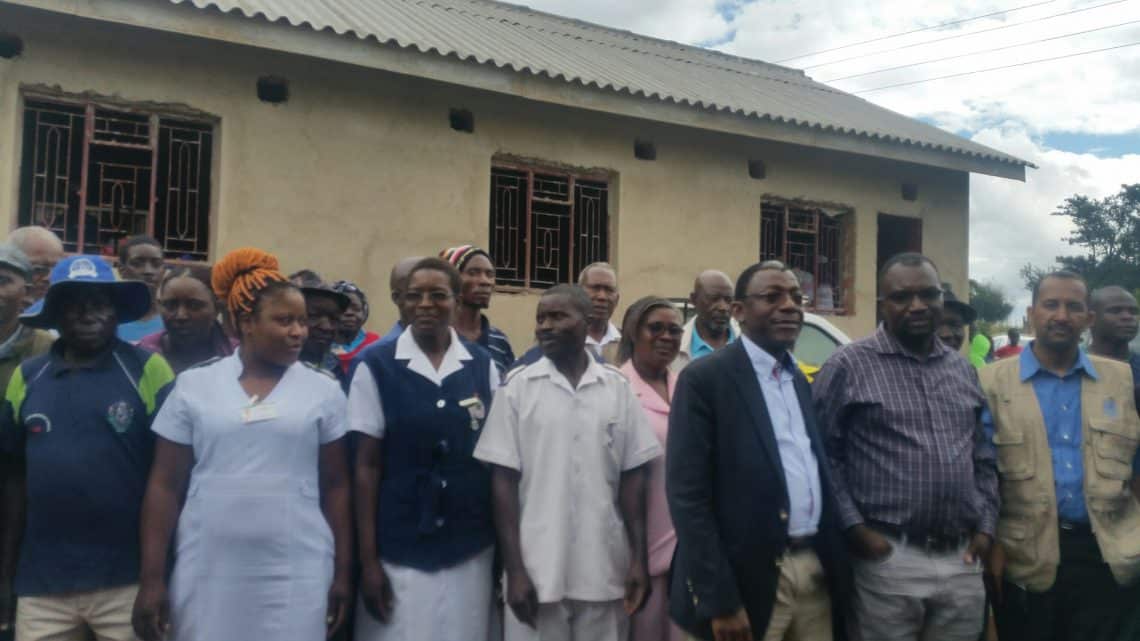By Byron Mutingwende
“My weight had reduced to 31kg but I am now at 50kg and improving daily. I am HIV positive and was susceptible to multiple infections. Thanks to the feeding programme at Sakupwanya Clinic here in Mutasa District, I look forward to living longer since my adherence to anti-retroviral therapy and TB drugs is now consistent because of the nutritious food I get from this health centre,” said a middle-aged woman in her testimony during the joint visit by the Food and Agriculture Organisation (FAO), the World Food Programme (WFP), the United Nations Children’s Fund (UNICEF), representatives of non-governmental organisations and senior government officials 0n 11 April 2018.
Patience Chindondondo, the Nurse-in-charge at Sakupwanya Clinic said the programme had reduced malnutrition of at risk people and enhanced adherence to medication of people living with HIV and TB.
“The feeding programme is helping in preventing malnutrition or stunting in all children aged 6-24 months. It is also enhancing the nutrition status of malnourished people living with HIV and non-stunting among children in their first 1000 days,” Chindondondo said.
David Phiri, the FAO Sub-regional Coordinator for Southern Africa said the programme was being implemented in Mutasa District after the 2010/2012 National Nutritional Survey revealed 42% versus the national average of 27%.
“We came up with the multi-sectoral collaboration among the UN agents and some NGOs after we realised that the Mutasa nutritional outcomes were not corresponding with the fact that the district has a high production of a variety of crops. We realised that there was persistent stunting despite the high crop yields hence the intervention,” Phiri said.
Mohamed Ag Ayoya, the UNICEF Zimbabwe Representative said his organisation offers support to pregnant women through iron and folic acid supplementation to reduce anaemia and lower birth weight that are the leading causes of stunting in children.
“We offer support to the immunisation programmes to childhood illnesses. We also give Vitamin A supplementation to children aged 6-59 months as well as growth monitoring and screening of children for malnutrition. We ensure the uninterrupted pipeline of ready-to-use therapeutic food to treat children with severe acute malnutrition. UNICEF supports data collection and management to improve information systems,” Ayoya said.
Since July 2010, WFP and Plan International targeted malnourished HIV and AIDS or the TB infected in the district. The programme was not well coordinated until July 2014 when the programme on reducing stunting started. From April 2017 to date, WFP, the President’s Emergency Plan for AIDS Relief (PEPFAR) and Plan International have been funding the programme on reducing stunting.
Unchanged activities since 2014 include assisted people monthly screening, registration, awareness and education information dissemination, social behaviour change communication as well as food distribution and monitoring.
Antnet Chitsiku, an environmental health technician for Ward 11 in Mutasa District who is on the Ward Food and Nutrition Security Committee blamed poor dietary diversity, early marriages, teenage pregnancy and diseases as some of the drivers of stunting in the ward.
“We as the ward are advocating for establishment of new water points. We are also constructing the Blair ventilated improved pit latrines at all the homes. Each homestead should have 3-tier refuse pit for biodegradable waste, plastics and bottles. We are also encouraging the use of hygienic home-made sanitary pads for women and girls,” Chitsiku said.
Nutritious porridge is given to children under 2 years of age, pregnant mothers and those with chronic illnesses. The testing and treatment of malaria is done at village level.
Theodore Kativhu, the Vice Chairman of the Sakupwanya Health Centre Committee revealed that the feeding programme had increased dietary intake and weight gains among beneficiaries.
“The frequent visits to the health centre has improved the health status of children and early detection or treatment of illnesses. There is also consistent adherence to ART or TB drugs due to availability of food. There is also antenatal care early bookings and village health workers’ visits to people living with HIV has risen from 8, 3% to 11, 5%,” Kativhu said.
George Kembo, the Director of the Food and Nutrition Council encouraged people to consume the rich, locally available foods, nutrients fortified or dense food. He called for the strengthening of livelihoods integration and partners’ collaboration to holistically address households’ food insecurity or nutrition challenges.






